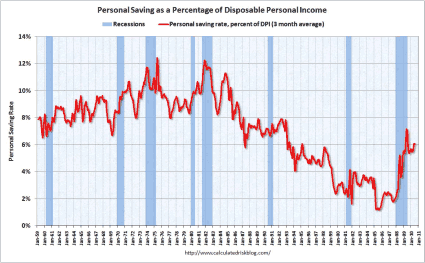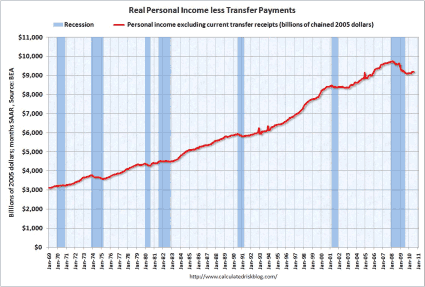In July, Personal Income rose 0.2%, after being unchanged in June, but still slower than the increase in either May (up 0.3%) or April (up 0.5%). It was also slightly below the consensus expectation of a 0.3% increase.
Meanwhile, Personal Consumption Expenditures (PCE) rose by 0.4%, slightly higher than the consensus expectation of a 0.3% rise. That is a significant acceleration from the unchanged reading in June and well above the rise of 0.1% in May and the 0.1% decline in April.
Of course, if spending is rising faster than income, it means that the savings rate is declining. The savings rate fell to 5.9% from 6.2%. The graph below (from http://www.calculatedriskblog.com) shows the long-term history of the savings rate (3-month moving average).
Over the long run, a higher savings rate is good for the country, and is desperately needed — the savings rate has been in more or less a constant secular decline for the last 30 years. Without domestic savings, we have to borrow from abroad to invest in the economy.
Capital imports are the flip side of the trade deficit. If we sell less abroad than we buy, then we go into debt abroad. That’s the same thing as importing capital.
Last 30 Years: Savings Fall, Debts Rise
The chronically low savings rate has left the country trillions of dollars in debt to the rest of the world. Note that is the 1960’s and 1970’s the savings rate was normally around 9 or 10%, and started a long secular decline after the 1982-83 recession. Prior to the 1980’s the U.S was the world’s largest creditor nation by a large margin. Now we are by far the world’s largest debtor. The fall in the savings rate and the increase in our indebtedness is not a coincidence, it’s a causal relationship.
In the short run, on the other hand, a rising savings rate slows down economic growth. If someone gets a raise, but does not spend more, then that raise does not stimulate other economic activity. If the raise is not spent, then there is no increase in aggregate demand. Staying home instead of going out to eat means that there is less work for waiters and cooks.
The desire of consumers to sit on their wallets and not spend increases in income is very understandable. The collapse of housing prices destroyed trillions of dollars of wealth. That wealth people had been planning on using to finance their retirements or put the kids through college. Now that money has to be replenished the hard way — by spending less than you earn. Note how the savings rate tends to rise during recessions.
Unfortunately, there is no way to go from a low savings rate to a high savings rate without the savings rate rising. The rise in the savings rate during the Great Recession was very rapid, and was one of the key reasons the recession was so severe.
We are still a long way from the sort of savings rate we had back in the 1960’s and 1970’s, but we are a lot closer than we were a few years ago. Slowly people are making progress on repairing their balance sheets, or at least they have over the last year or so. That progress, however, could be greatly undermined if the price of houses starts to go south again.

Personal Income
The increase in Personal Income, while less than expected, was of high quality. In total, personal income rose by $30.0 billion in July, after declining by $2.7 billion in June (Seasonally adjusted annual rates, as are all the subsequent numbers on the components of personal income). In July, $23.3 billion of that increase came from higher private sector wages and salaries, while in June private wages and salary income fell by $5.0 billion.
Wages in the goods producing sector increased by $6.3 billion in July, almost offsetting the $8.5 billion decline in June. Wages in the private service sector accelerated to an increase of $17.0 billion from an increase of $3.5 billion in June. The decline in wages from the wind-down of the Census was less severe as well, a drop of $1.4 billion rather than a decline of $3.6 billion. Overall government wages (including the Census), fell by $1.1 billion in July.
Private wages and salaries are the most important — and highest quality — form of personal income. Government wages have to be paid out of either taxes or government deficits.
Another important source of personal income is proprietors’ income. In other words, what the self-employed and small businesses were earning. That increased by $1.6 billion after falling $5.3 billion in June. However, more than all of that came from down on the farm, probably because the drought in Russia has pushed up prices for wheat.
Farm proprietors incomes rose by $5.5 billion in July after falling $0.2 billion in June. In contrast, non-farm proprietors’ income fell by $4.0 billion on top of a $5.3 billion drop in June. Thus, what we normally think of as small business income is still hurting. Farm proprietors’ income is tiny relative to non-farm at just $41.0 billion versus $1.0061 trillion. The July increase was 15.5%. That sort of increase is not likely to be repeated.
Rental income rose by $2.8 billion on top of a $1.7 billion increase in June. The strength in rental income is somewhat surprising given the very high vacancy rates that still prevail in most areas of the country for both residential and non-residential properties.
Capital income, or income from dividends and interest, fell by $3.4 billion after declining $1.4 billion in June. This is the dark side of the low-interest-rate environment we are in. This income is particularly important to retirees. They are finding that as their bonds and CD’s mature, they have to reinvest the proceeds at lower and lower rates. The decrease was all on the interest side, with dividend income rising by $1.4 billion while interest income fell by $4.8 billion.
The final big component of personal income is government transfer payments. Like government salaries, this source of income has to come from either taxes or increased deficits, so it is a less desirable source of personal income from the point of view of the economy as a whole.
However, it is still income that gets spent in the economy. Wal-Mart (WMT) really doesn’t care if the money spent in its stores is from the elderly using their Social Security checks or the dividends they get from their investments, or really if it is retirees shopping there or people still in their working years spending their wages there, or their unemployment benefits.
Over the long term, though, the economy cannot simply grow through ever-increasing amounts of money being handed out by the government. Those payments are very useful in the short run to help hold up overall consumer spending when the economy has turned soft, but in the long run, the economy needs income from wages and salaries, and from small businesses earning profits.
It is those earnings and profits that pay the taxes that support the transfer payments. It is then worth looking at personal income excluding transfer payments, as shown in the second graph (also from http://www.calculatedriskblog.com). Since it is a long-term graph, inflation plays a much bigger role over time, and the graph is based on real personal income rather than nominal (which the rest of the numbers in this post are based on).
Note that during most recessions (and the immediate aftermath) incomes excluding transfer payments flatten out, but do not fall significantly. The Great Recession was very different in that regard, with income ex-transfer payments falling by about 7%. We are now starting to see a very tentative recovery in it.

Social Security & Unemployment
Within the broad category of transfer payments, Social Security benefits increased by $10.7 billion in July — a big acceleration from the $0.4 billion increase in June. Over the longer term, Social Security payments are going to be increasing faster than most sources of personal income due to the demographics of the Baby Boomers retiring.
In the short term, many older workers who are now unemployed have opted to take early retirement, not so much out of a desire to retire early (and with a lower benefit per month from Social Security) but have done so because they had no other choice.
The increase in Social Security benefits was offset by a big decline in unemployment benefits. When extended unemployment benefits were allowed to lapse due to the Senate filibuster, more than 2 million people lost their benefits. That showed up as a drop of $14.7 billion (again at a SAAR) in unemployment benefits in July vs. a drop of just $1.0 billion in June.
Extended benefits have been restored, and people are flooding back to the system. As a result, unemployment benefits are expected to increase sharply in August. That should help, at the margin, to increase overall personal income in August. Some of that was offset by an increase in other benefits, which rose by $10.5 billion after rising by $8.2 billion in June. These include things like food stamps and Section 8 housing vouchers, but are not broken out in detail in the report.
Overall: Slightly Positive
Overall, I would have to rate this report as slightly positive, even though the headline number on personal income was less than expected. The quality of the income growth, with so much more of it coming from private wage and salary growth, more than makes up for the slight miss overall. Not a great report, but a marginally positive one, and we will take what ever good news on the economy we can get.
The big positive swing in PCE, rising $44.1 billion rather than falling at a $4.0 billion annual rate, means that the consumer is likely to add to GDP growth in the third quarter. Since PCE makes up over 70% of the whole economy, having PCE growing rather than shrinking is extremely important. Since we are not going to get a lot of support from the other areas of the economy — particularly residential investment and business investment in structures, as well as government spending — if the economy is going to grow at all in the third quarter, it will need a good showing from the consumer. So far so good on that front, but July is only one third of the quarter.
Over the long term, we want to see the savings rate rise, not fall, but in the short term, the drop in the savings rate is going to help the economy grow. Ideally what will happen is that incomes will grow faster than spending.
A big part of the increase in the savings rate we had early in the downturn came in the worst possible way, with spending falling faster than incomes were. That is a very dangerous development since the falling spending was actually causing incomes to fall. Less spending simply means fewer people working, and hence a fall in incomes.
WAL-MART STORES (WMT): Free Stock Analysis Report
- Bulenox: Get 45% to 91% OFF ... Use Discount Code: UNO
- Risk Our Money Not Yours | Get 50% to 90% OFF ... Use Discount Code: MMBVBKSM
Disclaimer: This page contains affiliate links. If you choose to make a purchase after clicking a link, we may receive a commission at no additional cost to you. Thank you for your support!


Leave a Reply